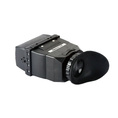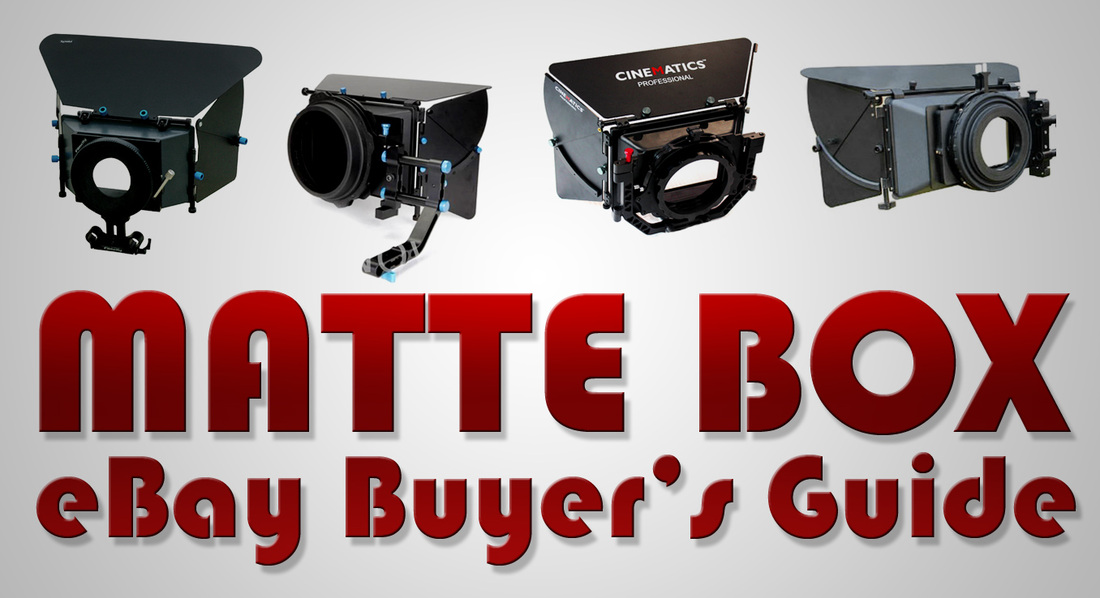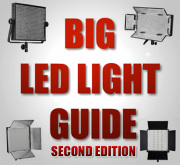We all know DSLRs are incredible Filmmaking tools. But lets not forget, it’s a stills camera, that has the video function, not other way round. To get the best out of it people like myself rig it up with different accessories like a shoulder rig to improve the ergonomics, follow focus to help achieve best focus and this clip on viewfinders to help with shooting in bright daylight, since there is no real EVFs on such cameras.
Relatively recently third party EVFs started appearing on the marked and a lot of well known filmmakers started caling that these are essential tools for DSLRs and Large Chip Camcorders, so I decided to invest into one. I bought my one second hand on eBay. It was sent to me from US, so with customs charges I ended up paying about £450 which is no exactly a bargain, not really the cheapest monitoring option for a budget filmmaker, but on the paper it sounded so good that I couldn’t resist it. This review is based on Cineroid performance with Canon 5D mark II, so some points will not apply to other cameras due to 5Ds poor HDMI output.
Let me start with the good points, the reason I bought it.
I really hate how most of the budget monitors show the image out of the 5D ones you press record button. The resolution drops and images stretches out, creating an ugly image. This is the main reason why I never invested in a liliput monitor. I’ve worked with one though and I didn’t enjoy the experience. Cineroid on other hand handles these problems much better. While resolution still drops, cineroid rescales the image back in to proper ration. And while I only get 480p resolution during recoding, the magnifying loupe helps to get the focusing right.
Another nice feature is the HDMI loopthrough. After being forced to use the liliput monitor on one of the shoots because director needed to see the picture clearly I decided that I need something like Cineroid which will give me a proper image while director can view the image looping through it into something like liliput. I’ve used this feature couple of times and it is one of my favorite things in this Cineroid.
Third reason for buying this evf is ability to put it anywhere, in particular on the side of the camera making the whole setup more ergonomic, just like boadcast camera. It is great way to use the camera on your shoulder. With an EVF I can have the camera virtually on my shoulder because I don’t have to look at the back of its screen making it much less front heavy than the usually DLSR setup where you offset the camera to the side allowing you to view the screen properly.
I like the flip up feature this evf has. It is really useful when I want to show the image to the director. The magnets hold the loop well in place, so no problems there.
One of the things I really miss in 5D is the peeking function. Due to it’s large sensor and lenses that create really shallow dept of field focusing can be very difficult especially when focusing on a moving subject. The peeking function seems to be got sent, but this is actually what brings me to the bad points of this evf. While peeking works fine in 5ds preview mode, once I press record and resolution drops to 480p the evf really struggles to deliver any proper peeking, which is obviously caused by low resolution coming from the camera, This is obviously camera specific, but I didn’t know that before I bought it. The peeking will probably work just fine on other cameras including Canon’s 7D and bigger cameras like Sony F3, FS100 and Panasonics AF101, but if have a 5D like myself or one of the other Canon DSLRs with a poor HDMI out, then don’t expect to get much out of the peeking function.
One of the other problems I get with my 5D is the unstable performance. Almost 50% of time, when I press record screen goes to black and just stays black. I must then stop the recording and start it again. For some reason when I press it quickly second time always seems to work. This inconsistency is very annoying and now I expect the monitor to freeze every time I press record, not good at all.
Before I bought Cineroid, I would read about how it is essential for DSLRS and large chip cameras because their monitors and evfs are really bad quality. Well let me tell you something, Cineroid display is actually very poor quality comparing to my 5D display. It’s not just about the resolution, more importantly, the color reproduction is very poor and judging the exposure accurately from Cineroid's image alone is virtually impossible. When I switch it off and look at the 5D display, The picture looks very different and the picture out of 5D is so much more accurate. Such quality would be an acceptable for cheap Liliput, but not for a £560 (new) evf. I've tested my Cineroid against a Zacuto EVF on one of the shoots a few months ago and Zacuto has much better screen quality, both color and exposure wise.
Few more bad point I found, are: The display image sort of refreshes when there is a lot of movement in the frame making this weird wave running across the screen. The menus are quite fiddly and if you try to customize the evf for you particular needs you get the glitches with software all the time. It is a shame that there seems to be no way all to upgrade the firmware, so whatever problems are there, they can’t be fixed.
My conclusion to this review is that this evf is really not worth the money you have to pay for it. If it was half the price, I would give it 4 stars, but at this price it going to be 2 out of 5 and I would not recommend this accessory to a budget filmmaker.
Relatively recently third party EVFs started appearing on the marked and a lot of well known filmmakers started caling that these are essential tools for DSLRs and Large Chip Camcorders, so I decided to invest into one. I bought my one second hand on eBay. It was sent to me from US, so with customs charges I ended up paying about £450 which is no exactly a bargain, not really the cheapest monitoring option for a budget filmmaker, but on the paper it sounded so good that I couldn’t resist it. This review is based on Cineroid performance with Canon 5D mark II, so some points will not apply to other cameras due to 5Ds poor HDMI output.
Let me start with the good points, the reason I bought it.
I really hate how most of the budget monitors show the image out of the 5D ones you press record button. The resolution drops and images stretches out, creating an ugly image. This is the main reason why I never invested in a liliput monitor. I’ve worked with one though and I didn’t enjoy the experience. Cineroid on other hand handles these problems much better. While resolution still drops, cineroid rescales the image back in to proper ration. And while I only get 480p resolution during recoding, the magnifying loupe helps to get the focusing right.
Another nice feature is the HDMI loopthrough. After being forced to use the liliput monitor on one of the shoots because director needed to see the picture clearly I decided that I need something like Cineroid which will give me a proper image while director can view the image looping through it into something like liliput. I’ve used this feature couple of times and it is one of my favorite things in this Cineroid.
Third reason for buying this evf is ability to put it anywhere, in particular on the side of the camera making the whole setup more ergonomic, just like boadcast camera. It is great way to use the camera on your shoulder. With an EVF I can have the camera virtually on my shoulder because I don’t have to look at the back of its screen making it much less front heavy than the usually DLSR setup where you offset the camera to the side allowing you to view the screen properly.
I like the flip up feature this evf has. It is really useful when I want to show the image to the director. The magnets hold the loop well in place, so no problems there.
One of the things I really miss in 5D is the peeking function. Due to it’s large sensor and lenses that create really shallow dept of field focusing can be very difficult especially when focusing on a moving subject. The peeking function seems to be got sent, but this is actually what brings me to the bad points of this evf. While peeking works fine in 5ds preview mode, once I press record and resolution drops to 480p the evf really struggles to deliver any proper peeking, which is obviously caused by low resolution coming from the camera, This is obviously camera specific, but I didn’t know that before I bought it. The peeking will probably work just fine on other cameras including Canon’s 7D and bigger cameras like Sony F3, FS100 and Panasonics AF101, but if have a 5D like myself or one of the other Canon DSLRs with a poor HDMI out, then don’t expect to get much out of the peeking function.
One of the other problems I get with my 5D is the unstable performance. Almost 50% of time, when I press record screen goes to black and just stays black. I must then stop the recording and start it again. For some reason when I press it quickly second time always seems to work. This inconsistency is very annoying and now I expect the monitor to freeze every time I press record, not good at all.
Before I bought Cineroid, I would read about how it is essential for DSLRS and large chip cameras because their monitors and evfs are really bad quality. Well let me tell you something, Cineroid display is actually very poor quality comparing to my 5D display. It’s not just about the resolution, more importantly, the color reproduction is very poor and judging the exposure accurately from Cineroid's image alone is virtually impossible. When I switch it off and look at the 5D display, The picture looks very different and the picture out of 5D is so much more accurate. Such quality would be an acceptable for cheap Liliput, but not for a £560 (new) evf. I've tested my Cineroid against a Zacuto EVF on one of the shoots a few months ago and Zacuto has much better screen quality, both color and exposure wise.
Few more bad point I found, are: The display image sort of refreshes when there is a lot of movement in the frame making this weird wave running across the screen. The menus are quite fiddly and if you try to customize the evf for you particular needs you get the glitches with software all the time. It is a shame that there seems to be no way all to upgrade the firmware, so whatever problems are there, they can’t be fixed.
My conclusion to this review is that this evf is really not worth the money you have to pay for it. If it was half the price, I would give it 4 stars, but at this price it going to be 2 out of 5 and I would not recommend this accessory to a budget filmmaker.

Click to find this item on ebay
Just very recently, after I wrote this review I bought a new Liliput monitor. I usually wouldn't look at one, but this little 5" thing actually seems to be a big improvement from their older range. Apparently it rescales the image back into proper ratio during the recording, has HDMI loopthrough and also looks quite cool, button design and layout virtually identical to some Marshall monitors. Best of all it is very cheap. On the paper sounds like a great monitor for a DSLR, should be a much better value for money than Cineroid, but I don't want go speculate until I try it out myself. The model number is 569GL, so if you want check it out yourself, otherwise wait for my review.

Click to find this item on ebay



 RSS Feed
RSS Feed
